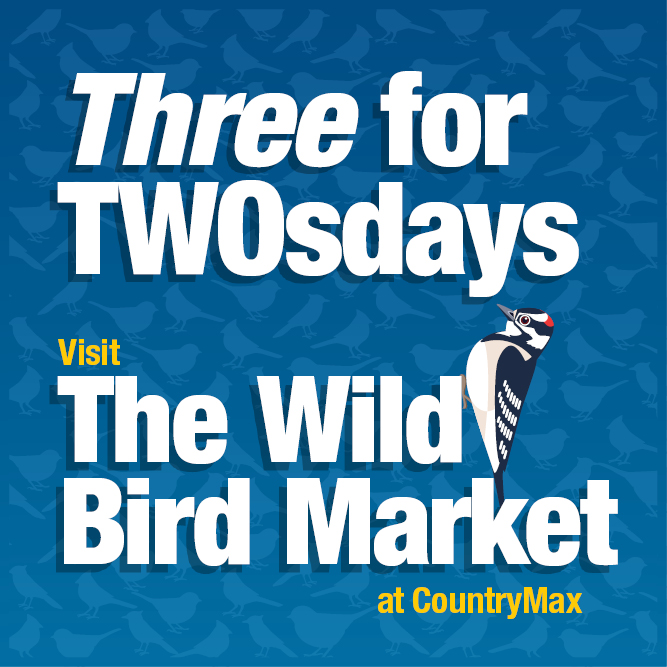Backyard Bird Life: February


The Wild Bird Market at CountryMax makes it easy to get started.


The National Bird-Feeding Society promotes February as national bird feeding month. It all started back in 1994 when Congressman John Porter proclaimed it.

I would like to recognize February, one of the most difficult months in the United States for wild birds, as National Bird-Feeding Month. During this month, individuals are encouraged to provide food, water and shelter to help wild birds survive. This assistance benefits the environment by supplementing the wild bird’s natural diet of weeds, seeds and insects.
– John Porter

Since then, there have been many themes for the month. But the essence is the same – now’s the time to support your local wild birds! Of course, you can do more than simply filling your feeders. Here are some additional ideas to celebrate the season.
Bird Watching
Whether you’re new to feeding birds or have been doing it for years, now is a great time to slow down and really watch those feathered friends. With bare trees, you can see where they go before and after stopping at your feeder.
Photography
With a camera phone or DSLR, you can catch exceptional wild bird photos in the wintertime. The air is crisp, and the contrast of birds against a stark background can lead to sensational images.
Provide Water
Freezing temperatures make it tricky for birds to find water. If you have a pump to keep water moving, use it so birds can avoid dehydration. Need one? CountryMax has a selection of affordable pumps and accessories.
Add a Feeder
You may already have one or more feeders, but different styles and seed products appeal to different species of bird. Mix it up and you’ll see a greater diversity of birds than ever before.
Tell a Friend
About one-third of households in the U.S. enjoy feeding wild birds. That means there’s plenty of room for more! Share your bird-feeding enjoyment with a friend or family member. It’s something people can enjoy at every age. In fact, share this link to our online Wild Bird Guides.

In-store sales. Max Rewards members only.
No rainchecks. Buy two at regular price, get one free of same size and SKU.
We’re giving you a reason to love Tuesdays:
Buy two, get one free! Every week is a different, money-saving deal that not only gets you more for your feeders, but also more Max Rewards points. See all the upcoming deals!



We are hosting live Master Gardener seminars including how to attract pollinators – butterflies, bees, and certain birds – to your garden. You might be surprised that late winter is a great time to get started planning your pollinator garden. Here are a few tips gleaned from the master gardeners who present at our stores.

Select your location carefully
Butterflies and other pollinators like the sun. Many wildflowers grow best in full or partial sun. So look for a sunny spot, that doesn’t get too much wind, and that will likely be your best bet.

Choose native plants
Why are native plants so important? Not only do they require less maintenance, but they tend to be hearty. This is their home. And they’re what pollinators expect to find here. Milkweed and wildflowers are the attraction. But they can’t be treated with pesticides or insecticides. Speaking of low maintenance, be sure to choose perennials so you they come back year after year.

Mind the soil
Soil type and sunshine determine what kinds of plants you can grow. Be sure your soil is rich enough and has proper drainage for the types of plants you want to thrive.

Seeds are a great option
If you have the patience to wait, seeds are an economical way to go, especially for a large garden area. If using seeds, get them started in late winter so there’s plenty of germination time before summer. You can scatter them over the snow! Of course, nursery plants will be ready to attract pollinators almost right away. You’ll spend a little more money, but see results faster.

Water, weed and welcome those pollinators
It takes time, but this summer you could see butterflies and other pollinators visiting your backyard on a regular basis. Milkweed can take a couple of seasons to start flowering. Like any garden, you need to water and weed.

As the #1 source for wild bird seeds and supplies, we decided to make it super-easy to get started with this satisfying hobby. For under $30, you get everything you need to enjoy wild bird feeding month right away. Perfect as an added feeder in your yard, or as a gift to someone just getting started this year.

Ranch feeder
This handsome, high-quality feeder comes straight from the CountryMax Woodshop. It’s a dual-purpose feeder – seeds and suet.
1. Fill the center with premium seeds and watch cardinals, blue jays, tufted titmice and more come to your backyard for a much-needed mid-winter feast.
2. Add suet on both sides and you’ll welcome a whole bunch more of your feathered friends. Woodpeckers, chickadees and nuthatches are just a few of the species that seek out the high-protein nourishment of suet.
This bundle includes a 7 lb. bag of an ultra-premium seed blend made with high levels of black oil sunflower seeds to attract the most desirable birds to your backyard.
Also included are two cakes of best-selling suet. High quality beef tallow means a higher melting point for year-round feeding. Guaranteed not to turn rancid. Contents include all the tasty, nutritious things wild birds love – rendered beef suet, corn, milo, wheat, millet and, of course, sunflower seeds!

